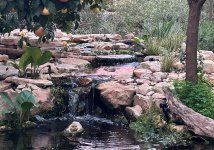- Joined
- Apr 14, 2022
- Messages
- 27
- Reaction score
- 5
- Country

Good afternoon.
I built a pond a few years ago with 2 streams coming from above, leading to it.
My problem with them is that no matter what I do, very little water comes down the streams. I’ve added more pond pumps and even just held my garden hose up top to see what would happen and no matter what, only a little bit of water will just softly go underneath the rocks.
I’m trying to post a picture, but it keeps saying that the file is too large. I will try to reply with the picture to see if that works. In the picture, you can see that the top of the rocks are completely dry and the small amount of water that is going into the pond.
When I first planned this project, I envisioned the streams being filled with water rather than just trickling. I currently have two 1,200gph pumps going roughly 6 feet up to provide water to it. My only theories are that I need a much more powerful pump or I need to build the streams on a higher slope.
Any advice would be appreciated. The ponds been beautiful the way it is, so I haven’t messed with it, but this year I finally want to make the streams more what I initially envisioned.
I built a pond a few years ago with 2 streams coming from above, leading to it.
My problem with them is that no matter what I do, very little water comes down the streams. I’ve added more pond pumps and even just held my garden hose up top to see what would happen and no matter what, only a little bit of water will just softly go underneath the rocks.
I’m trying to post a picture, but it keeps saying that the file is too large. I will try to reply with the picture to see if that works. In the picture, you can see that the top of the rocks are completely dry and the small amount of water that is going into the pond.
When I first planned this project, I envisioned the streams being filled with water rather than just trickling. I currently have two 1,200gph pumps going roughly 6 feet up to provide water to it. My only theories are that I need a much more powerful pump or I need to build the streams on a higher slope.
Any advice would be appreciated. The ponds been beautiful the way it is, so I haven’t messed with it, but this year I finally want to make the streams more what I initially envisioned.


